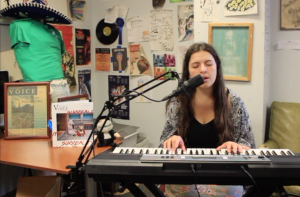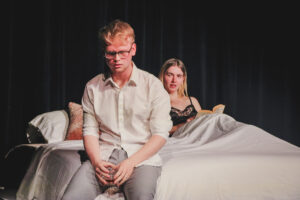I have been waiting for a proper Georgetown vs. George Washington (GW) showdown since my freshman year. The tension is impossible to ignore—whether bar-hopping in Foggy Bottom or shopping on M Street, both school populations have given and received their fair share of snide comments and dirty looks.
The perfect stage for this long-awaited showdown finally arrived on Oct. 19. Through a collaboration between WGTB and WRGW, Georgetown and GW’s respective radio stations, four bands were selected to perform on Copley Lawn. The contest rewards were two-fold: a cash prize was up for grabs based on audience vote, and a panel of judges would reward one lucky band with an entire day in a professional recording studio.
When I arrived at the show, I picked my spot carefully, as the crowd was seemingly split down the middle between the two respective schools. But as the night went on, people started to mingle together, and the indie Hoyas came out to play with the slightly grungier crowd of Revolutionaries (yes, that’s their actual mascot).
Lucy Child (CAS ’24) offered her opinion on the significance of the event. “More than anything, I feel like this is the first time we’ve had anything like this on our campus. And live music, especially from students, it’s super cool to see. It feels very college, it feels very fun,” she said.
Another concertgoer, Maeve Foley (CAS ’24) brought a similar insight. “I also think everyone comes into it wanting to ride for whatever school they’re coming from. But, like, it’s just so fun that you can’t really help but, like, cheer for whoever’s up there. And yeah, it’s a cool time.”
That atmosphere of “this is so college” was emphasized by the college-rock style of the second band, Dundrum from GW, who arrived on stage to yells and hand signs of “I love you” from the crowd. Given their visible popularity, the Georgetown students looked inquisitive as the band set up on stage.
Dundrum’s instrumentation and vocal style would most definitely fall under the umbrella of alt-rock, but their adherence to genre definition stops there. They opened with a spoken-word section that was followed by a psychedelic breakdown. The guitar chords slowed down to create a sultry solo, and the singer stepped back from the mic to let the band carry the show.
However, after this song, the vibes of the set grew continually more upbeat, and the crowd started moving as one. GW kids opened a circle in the center of the crowd to start a mosh, and their energy did not disappoint. Dundrum was leading the crowd with a metal-grunge fusion that fueled the bodies slamming into one another. As a hardcore guitar solo ripped across the crowd at the end of the set, Dundrum planted themselves into the running for the best band.
In a Voice interview with Dundrum after their set, the band revealed some of their influences. The frontman, Andrew Gibson, and the lead guitarist, Dylan Weiss, cited post-metal band Death Heaven, emo band Oso Oso, and post-rock innovators Slint as important touchstones in their musical history. In response to the energy they were able to create from the crowd, Gibson says the best method seems to be to go on stage with a “brain empty, just music” mindset.
The last band was Pain Thinner from GW—not Paint Thinner, which they made very clear. They announced that this was their first show, which received shouts of support from the entire crowd. The distortion of the guitar reminded me of Deftones, producing gothic dark tunes that the speakers couldn’t really handle. Despite their lack of performing experience, Pain Thinner provided a fresh take on what was one of my personal favorite genres that was both familiar and exciting.
When the GW students opened up the mosh again, the crowd expanded to make room. Even though their music wasn’t as fast as Dundrum, Pain Thinner carried the pit well with a heavy moaning guitar and a high-pitched tone from the singer, creating a welcome dissonance and fueling the musical chaos.
Marco Mastro-Pietro, a GW student, offered his opinion on Pain Thinner’s set. “I love it, Pain Thinner did so well. It was very fun, I was kind of sad that there wasn’t a mosh at first, so I tried my best to incite it here.”
The offerings from Georgetown brought a different vibe entirely— the first band, The Ordeal, could only be described as Weezer and Clairo’s musical love child, featuring swanky guitar solos with a soothing backbeat. They weren’t just indie copy-cats, though; the contrast between their first and second songs, a slightly edgier song followed by a summery tune, demonstrated their versatility. As their set continued, passersby also stopped to enjoy the show.
Georgetown class of 2024 favorite, Rosewater, continued the more relaxed vibe of their fellow Hoyas. Opening with a cover of “Brazil” by Declan McKenna, the indie energy was back in business. They beckoned the crowd forward, demanding intimate engagement with their fellow students. Even when there was a technical malfunction with the mics, the show went on—the band didn’t blink an eye and handled it very well, allowing the crowd to lead the melody.
Their second and third tracks were more like ballads, creating a different vibe to the crowd compared to Dundrum. Mosh pits turned to swaying and headbangs turned into gentle bops. Definitely a transition, but not an unenjoyable one. This dichotomy seemed to be needed for the Georgetown kids, who were ready for Rosewater’s indie takeover from their enthusiastic screams of support. Their next song channeled Janis Joplin, with the lead singer having a deeper growl to her voice. The guitarists moved together, creating a Summer of Love moment on Copley Lawn.
When the audience votes rolled in, Rosewater took the cake by three, winning the cash prize. To the dismay of the Revolutionaries in the crowd, Hoyas proudly screamed for their chosen representative. The judges, however, chose Dundrum, who hopped on stage with ultimate excitement for their studio day.
The stark difference in music styles between the Georgetown and GW contestants was interesting to see, as the character of each school shone through in their music styles. Georgetown was simply preppier, presenting more upbeat songs that seemed to match the peaceful vibes of Dahlgren Quad or the relaxing views on the LXR rooftop. GW gave us an edgier slice of D.C. music, possibly from closer proximity exposure to the center of D.C. and the sheer size of the school in comparison to Georgetown.
Despite the cheesy school rivalry, this event was amazing to see, representing the vitality of the live college music scene in D.C. that has seemed so lost in the past few years. The surprising gathering of our neighboring schools brought a different vibe to Copley Lawn that day. It didn’t feel like the same place where the Farmer’s Market takes place on Wednesdays or where we all sat for convocation but, instead, like something exceptional—an amalgamation of D.C. college talent that the audience beyond were ready to enjoy.





